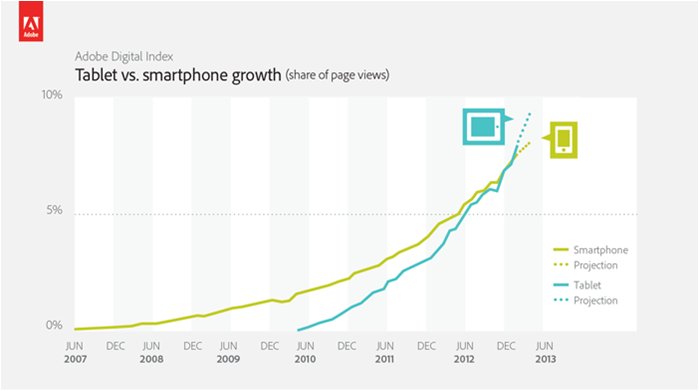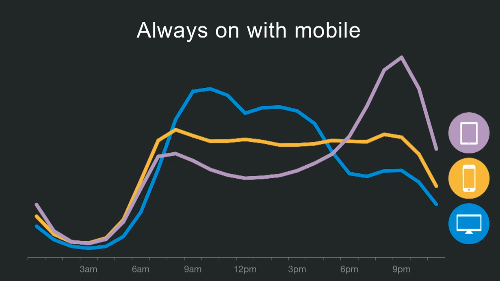The line between the desktops, tablets and smartphones is blurring and this means a new challenge and a reality to all enterprises. As a consumer, we have adopted tablets and smartphones apps at a much faster rate compared to that of the enterprise adoption. With the BYOD trend, it gets even more trickier for the IT folks to provide Mobile application access on multiple devices and make sure that the data is secure.
In a recent projection, the smartphone and tablets seem to have taken most of the workforce and the enterprise work is being “redefined”. According to Adobe Digital Index, the user engagement and share of page views on Tablets have long surpassed that of the smartphone. No longer we are working just at the desk and that means we need to get right information at the right time on tablets and smartphones. However, this poses a fundamental question on device priorities.
“Should your App be on Tablet or on Smartphone ?”
Irrespective of the size of the company, you have limited resources and we need to make sure that our enterprise mobile priorities makes sense for the “end users”. Here are the two questions that you consider when deciding the Tablet vs Smartphone strategy. It is that simple.
Who are the end users?
For the most part, an enterprise application caters to more than one user profile. As an example, it could be an IT Administrator, Application Administrator and end users. Your users could be a Sales Manager, Marketing Executive, Executive Management, IT Analyst, Finance Manager, Construction Architect, Medical Supervisor, Highway Patrol Officer, etc… As you could imagine each of them has different needs and the way they consume data is different.
On a high level it is important to understand categories of end users.
What are the usecases?
Once you identify the end users, make sure you go deep to understand what functions each of these users do. Typically each user would navigate through set of features to accomplish a business task. Once you understand the usecases, prioritize which usecases will make it to mobile App. Remember, we still have not decided if it is a Tablet App or Smartphone App. In the process of prioritization, it could even be that some users may be totally eliminated from considering a mobile access via App. e.g. If your enterprise application has “Application Designer” as the user who designs the UI via a form designer, you may chose NOT to target this user with this App. Many times, you DON’T want to replicate all usecases on the mobile App.
Once you prioritize the usecases, chose to go with Tablet if at least three points from below criteria are true.
- Usecases involve heavy/medium data entry.
- Usecases involve showing decision making data.
- Usecases represent data in grid, hierarchical forms and drill-down data structures.
- Usecases need to show a lot of dashboards.
- Usecases need heavy document management and offline access.
As a final point, clearly the user experience on the Tablets and Smartphones will be clearly different. Don’t try to squeeze in the UX built for Tablet into Smartphone and vice-versa. Even if the same user is accessing the App on Tablet and Smartphone, what user sees and interacts might be totally different.
Note : The only external factor (and an important one) to take into account is how savvy are your end users and if your customer organization is willing to provide Tablets to your users. Sometimes we might be limited to provide just a Smartphone App and not think about Tablets because companies may not have a Tablet strategy at all.
Picture Credits : Adobe Blog and LinkedIn Mobile Strategy Webinar.

